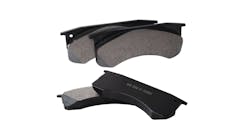Tires are one of the largest expenses for commercial fleets, and many sources consider them the top maintenance cost. Like many other areas of the transportation industry, tires are benefiting from new, advanced technology that can help companies reduce downtime and save money.
One major advancement in recent years is the development of digital tire monitoring technology, which effectively eliminates the need for manual tire pressure checks.
Why monitor tire pressure and temperature?
On average, 34 percent of fleet tires are underinflated, according to data collected by Continental. Tires typically lose up to 2 percent of their air pressure every month. Worn valve stems and temperature changes can increase the amount of pressure loss, as can nail holes and other tire damage from demanding applications such as waste hauling. According to Continental’s Research and Development team, fleets should check their tire pressure at least once a week to help extend the life of their tires – but daily would be even better.
A tire that is underinflated by as little as 2 percent can exhibit irregular wear and other tire issues. A properly inflated tire experiences a 1 percent increase in fuel efficiency, 15 percent longer tread life and 20 percent longer casing life, versus a tire that is just 10 percent underinflated. According to the Technology & Maintenance Council of the American Trucking Association (ATA), improper tire inflation increases total tire-related costs by approximately $600 to $800 annually per tractor-trailer combination.
Underinflated tires are also a leading cause of tire failure on the road. When a tire is underinflated, the sidewall flexes significantly during rotation, causing it to build up heat and weaken the tire. Monitoring the tire temperature is a key metric to help warn of an impending tire blowout, which could lead to immediate costs from roadside service, time lost and late deliveries, as well as danger to the vehicle driver and others on the road. In short, if you want to increase safety and save money on your tire program in both the short term and the long term, the key is monitoring inflation and temperature.
Types of monitoring systems available
Why is tire inflation so hard to monitor? Well, manual pressure checks are time-consuming. Reaching the air valve of the inside dual tire can sometimes be nearly impossible. Drivers may not get paid for the time spent performing pre-trip inspections, increasing pressure to finish quickly.
Fortunately, now there are other options. There are several types of commercial tire pressure monitoring systems (TPMS) available on the market.
These systems all measure tire pressure, which is critical for extending tire life. In addition, many measure temperature, and may also integrate with third-party telematics companies to provide data in real-time while vehicles are on the road.
Valve-mounted options are inexpensive and easy to install, but fleets may find the sensors can be damaged by curbing. In some cases, valve-mounted options could also cause tire failure if the valve stem is torn during the event. It is important to note tire temperature, one of the key measures to avoid tire blowouts, is not measured by valve-mounted systems, but rather calculated via an algorithm, which in some cases can lead to inaccurate results.
Another type of TPMS is wheel- or rim-mounted. While protected from damage caused by curbing, this type of sensor may be damaged during the tire mounting or dismounting process. In addition, the metal band attaching the sensor to the rim receives heat as the wheel turns, causing expansion and contraction of the clamp. After a period of time, the clamp may loosen and allow the sensor to spin around the rim, causing damage. In terms of measuring temperature, the sensor can be influenced by heat from the vehicle’s braking system, in which case it would not deliver accurate tire temperature data.
The third type of TPMS uses a tire-mounted sensor glued to the inner liner of the tire. While it requires dismounting the tire in order to install the sensor, it protects the sensor from damage and theft, eliminates the need for a metal clamp and delivers the most accurate temperature data.
These sensors can deliver tire pressure and temperature data wirelessly to the vehicle or the fleet terminal, either by way of an onboard control unit, or a reader station mounted in the fleet terminal, respectively. There are oftentimes options to integrate this data into a third-party telematics system as well.
Summary
Regardless of what type of tire monitoring solution you choose for your fleet, it can bring significant benefits by increasing uptime, extending the usable life of your tires, and improving safety. With this technology, tire pressure can be monitored accurately for all tires on the vehicle simultaneously, eliminating the need for manual tire pressure checks.
If your goal is to reduce roadside breakdowns and save money on your tire program, then digital tire monitoring might be just the solution you need.
As Head of Business Development, Digital Solutions, Commercial Vehicle Tires the Americas for Continental Tire the Americas, Michelle Reinhart is responsible for managing digital solutions, which includes ContiPressureCheck, ContiConnect, and intelligent tire applications.



